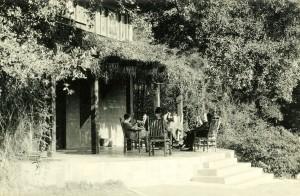Westmont Magazine A New Life for an Old Building
Originally built in 1912-1914 to house students, Westmont’s music building served as the Junior Dormitory of the Deane School for Boys until the school closed in 1934. Headmaster Hewitt Reynolds owned the campus and later leased the Junior Dormitory and other Deane School facilities to Westmont from 1951 to 1965. Women moved into the old dormitory, which became known as Unit I.
During the next two years, tenants painted the buildings psychedelic colors before trashing them. Westmont purchased the entire property in 1967, which required extensive repair. Units II and III became Deane Hall and Reynolds Hall, both housing faculty offices. The college planned to tear down Unit I to make way for a new residence hall and used it for storage in the interim. For a semester in 1968, students operated a coffee house there that provided food and entertainment and featured an art gallery for student work. But its poor condition prevented further use. In 1972-73, local youngsters broke in, turned the building into a hang-out, and started a fire that damaged the main room.
William Woollett, an artist and retired architect, discovered the buildings in 1972 and urged the college to preserve them. Inspired by Woollett, David Shelton ’70 submitted a proposal in 1975 to restore Unit I and the surrounding area. The two men worked with several faculty members on the idea, which involved transforming the old Deane School into a fine arts complex with an art gallery in Unit I. Meanwhile, Santa Barbara County declared the Deane buildings historical landmarks in 1980.
The cost of the restoration kept the college from adopting the project. Art professor John Carlander then took an interest in Unit I. Housed in one room upstairs in Reynolds Hall, the art department desperately needed space. Carlander envisioned Unit I, noted for its skylights, as an art center. Shelton had started minor restoration, but much work remained. Estimates put the cost of full renovation between $400,000 and $600,000.
Tony Askew soon joined the art faculty and worked with Carlander to pursue the idea of an art center. Receiving permission to raise the necessary funds, the professors launched a campaign in 1985. Grants from the Times-Mirror Foundation and the Ahmanson Foundation, fundraising events on campus, sales of Corita Kent’s poster “Leaping into the New: Arts Ascent at Westmont College,” and gifts from individuals yielded $500,000.
Work began, and the architects carefully preserved the building’s exterior appearance while creating a classroom and Reynolds Gallery downstairs and art studios and offices upstairs. Covered porches on each side of the building provided space for printmaking and ceramics. The glass panels separating the gallery from the hallway expanded the area available and turned much of the first floor into exhibit space. Naming the gallery for Hewitt Reynolds, the Deane School headmaster, acknowledged the building’s history.
The new Art Center was formally dedicated Jan. 19, 1986. Corita Kent gave a brief address, and children from the Arts Ascent program sang “We are the World.”
The Art Department had launched Arts Ascent the previous year to help people of all ages discover their creative potential and develop aesthetic awareness. During the summer, children attended a day camp and explored music, drawing, painting, crafts, drama and pageantry. Adults took workshops on drawing, painting, watercolors, printmaking, calligraphy, fashion illustration and design, ceramics, and theater arts and communication skills. Five hundred children enrolled the first summer. But its success doomed the program as the art department couldn’t keep up with the demand and ended Arts Ascent after a few years.
The art department gratefully made their home in the old Unit I until they moved into Adams Center for the Visual Arts in 2010. Their exit made way for the music department and another renovation, opening a new chapter in the building’s colorful history.

